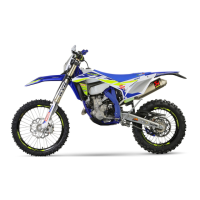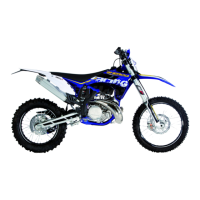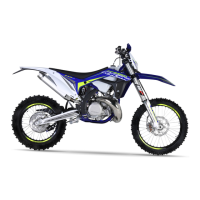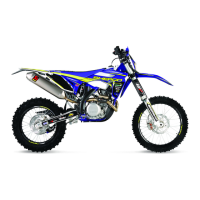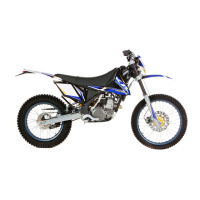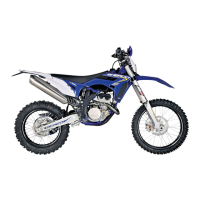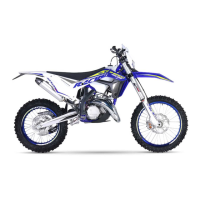Do you have a question about the SHERCO 250 SEF/R and is the answer not in the manual?
Guidance on recording vehicle and engine serial numbers for identification and tracking purposes.
Specifications for vehicle dimensions, motor type, displacement, bore/stroke, and compression ratio.
Details on the transmission, starting system, valves, spark plug, and engine oil.
Specifications for the frame, fork, rear suspension, travel, brake discs, and tires.
Details on electrical components and adjustment settings for Sachs and WP front forks.
Settings for WP rear suspension and a list of recommended cleaning products and consumables.
Identification of key motorcycle components visible from the right and left sides.
Labeling of controls and visual guide to finding vehicle and engine serial numbers.
Explanation of clutch/brake levers and left handlebar switch functions, including lights and horn.
Instructions for operating the main light switch.
Details on right handlebar switches, dashboard display, and key switch operation.
Instructions for using the flasher switch for turn signals.
Operation of engine on/off, emergency stop, and injection mapping selection switches.
Instructions for using the gear selector, side stand, and rear brake pedal.
Overview of computer display screens and how to operate mode buttons for navigation.
Explanation of SPD, MAX, AVG, DST, and DST2 functions for speed and distance tracking.
Details on Odometer (ODO), Accumulated Ride Time (ART), and low battery warning functions.
Instructions for configuring units, clock format, and maintenance reminders via the setup menu.
Procedures for opening and closing the fuel tank filler cap.
Instructions for starting the engine and shifting through the gears.
Steps for downshifting, engaging gears, and safely parking the motorcycle.
Essential safety advice including alcohol, helmet use, and daily pre-ride checks.
Steps for filling the radiator and replacing the bleed screw, including safety warnings.
Procedure for checking coolant level and draining the system, with environmental considerations.
Detailed steps for refilling the cooling system with the specified coolant after draining.
Instructions for checking and adjusting the throttle cable play for optimal throttle response.
Procedure for verifying the engine oil level and topping up if necessary.
Steps for draining old engine oil and removing the oil filter and pre-filters.
Details on removing, cleaning, and inspecting the oil filter cover and pre-filters.
Procedure for installing new oil filter, drain plugs, and refilling with correct engine oil.
Instructions for adjusting handlebar position by moving clamps in the triple tree.
Adjusting steering angle and basic chassis settings based on rider weight.
Procedure for adjusting fork compression damping for Sachs and WP suspension.
Adjusting fork rebound damping and spring preload for WP suspension.
Adjusting low-speed and high-speed compression damping on the rear shock absorber.
Adjusting rear shock rebound damping and measuring/adjusting sag.
Instructions for changing shock preload and replacing the rear shock spring.
Procedures for saddle removal/installation and air filter removal/cleaning.
Steps for correctly reinstalling the air filter and applying grease to the filter element.
Detailed steps for removing the fuel tank, including disconnecting fuel lines and electrical connectors.
Instructions for reinstalling the fuel tank and purging air from the front forks.
Cleaning fork dust seals and checking for play in the steering head bearings.
Instructions for adjusting steering head bearing play to eliminate looseness or resistance.
Guidelines for cleaning the drive chain and checking its tension.
Steps for adjusting the drive chain tension to the correct specification.
How to adjust the position of the clutch and brake levers for rider comfort.
Procedure for checking and topping up the clutch fluid level.
Step-by-step guide for safely removing the rear shock absorber from the motorcycle.
Instructions for reinstalling the rear shock absorber, including torque specifications.
Procedures for removing, cleaning, and reinstalling the front wheel, including brake disc care.
Procedures for removing and reinstalling the rear wheel, including spacer and chain alignment.
Regularly checking tire pressure and inspecting tires for wear and damage.
Instructions for checking spoke tension and seeking dealer adjustment if needed.
Adjusting front brake lever free play and checking front brake fluid level.
Filling front brake reservoir and adjusting rear brake pedal position.
How to check the travel and free play of the rear brake pedal.
Instructions for adjusting the travel of the rear brake pedal.
Checking and refilling the rear brake fluid reservoir.
Procedures for removing, checking condition, and reinstalling brake pads.
Steps for safely removing and reinstalling the motorcycle battery, including electrical precautions.
Instructions for charging the motorcycle battery using a suitable charger.
Procedures for replacing fuses and removing the headlight housing assembly.
Instructions for reinstalling the headlight housing and replacing bulbs or pilot lamps.
Adjusting headlight beam and replacing the motorcycle computer's small battery.
Recommended procedures for washing the bike and preparing it for long-term storage.
Steps to prepare the motorcycle for use after a period of storage.
Scheduled maintenance tasks for engine, injection, accessories, and cooling systems.
Scheduled maintenance for brakes, chassis, suspension, wheels, and tires.
Key maintenance items to be performed annually by an authorized dealer.
Regular checks and maintenance tasks to be performed by the rider before and after each use.
Specific maintenance intervals for competition and recreational motorcycle usage.
Tightening torque specifications for various engine and chassis components.
| Front Tire | 90/90-21 |
|---|---|
| Rear Tire | 140/80-18 |
| Fuel Tank Capacity | 9.7 L |
| Fuel System | Electronic fuel injection |
| Cooling System | Liquid-cooled |
| Starting | Electric starter |
| Transmission | 6-speed |
| Clutch | Wet multi-disc |
| Rear Suspension | Monoshock |
| Front Brake | Single disc, 260 mm |
| Rear Brake | Single disc, 220 mm |
